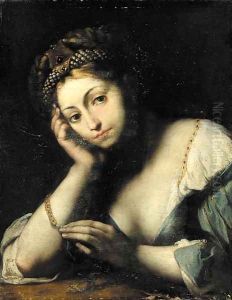Girolamo Forobosco Paintings
Girolamo Forabosco, also spelled Forobosco or Furobosco, was an Italian painter of the late-Renaissance or Mannerist period. Born in Padua in 1538, Forabosco was part of the Venetian school of painting, although not as widely recognized as some of his contemporaries. His work is characterized by the use of color and the elegant, sophisticated portrayal of subjects, which was typical of the Venetian style at the time.
Forabosco's artistic career was mainly centered in his hometown of Padua, but he also worked in other cities in the Veneto region. He was influenced by artists such as Titian and Tintoretto, which is evident in his use of color and the dynamic composition of his figures. However, information about his life and work is not as abundant as that of the more illustrious masters of his era.
Despite his relative obscurity in the annals of art history, Forabosco contributed to the art of his time with religious paintings, portraits, and mythological scenes. His work received recognition from his peers and patrons during his lifetime, and he was known for his ability to capture the essence of his subjects with a certain psychological depth, a skill that was highly appreciated in portrait art.
Girolamo Forabosco's death in 1605 marked the end of his contributions to the Italian Renaissance. While his legacy may not have the same lasting impact as the giants of the period, his paintings remain as a testament to the rich tapestry of talent that existed during this flourishing period of artistic expression. Today, his works can be found in various museums and collections, where they continue to be studied and appreciated by art historians and enthusiasts.
